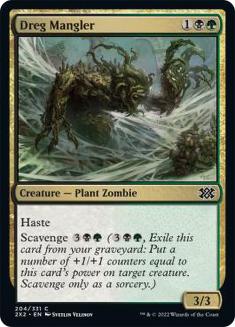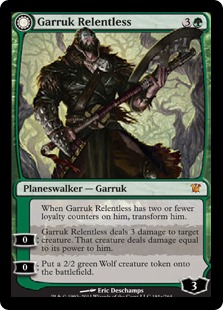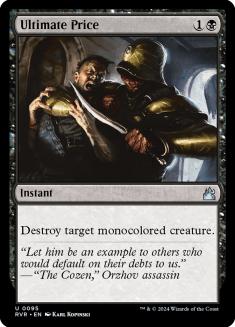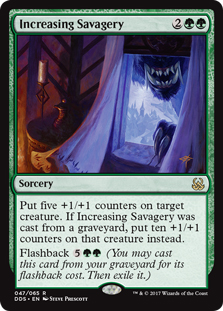Feature Match vs. Jackie Lee
I did not know what cards were in Jackie Lee deck and had never played before against B/G. In game 1, I was terrified that Ulvenwald Tracker plus Lotleth Troll would prove unbeatable since I didn’t have much action and only had four removal spells I could draw to remove the Tracker. Luckily, Jackie was landlocked and couldn’t fight without giving up her entire turn. Jackie’s sole mistake, as far as I could tell, came on the turn when I attacked with only Gravecrawler and she chose to block and regenerate. The alternative play is to not block and use the Tracker to kill Diregraf Ghoul, which I can’t recast the way I can recast Gravecrawler, thus resulting in me having one fewer creature.
She asked later whether she made a mistake in tapping out on the turn she cast Increasing Savagery:
She could have instead held back with Ultimate Price, risking me punishing her with Hellrider or Thundermaw Hellkite. Her exact hand was:
At the time, I thought it was correct to do what she did, as hanging back leads to a situation where things seem to be getting steadily worse and she is unlikely to win, but on detailed reflection and knowing her hand, hanging back seems right.
The chance of me having a new threat is high, as I’ve clearly been thinking about my plays, have no land in my hand, and just cast double Gravecrawler two turns after passing the turn, which means that my hand consists of cards that all cost four or more mana. I’ve cast one Aristocrat, which makes Hellrider more likely than Aristocrat, as does my extended thinking about what to do. The way it played out puts her at one life without the Tracker, so there are almost no scenarios where she can get out alive given I’m not holding land in my hand.
How does that turn work out if she hangs back? She kills the Hellrider, I attack, and she can only trade while taking four to eight damage. From that point, she untaps and can cast only one spell per turn, so it’s unlikely she can win from there, but it’s possible if she draws well and I stumble.
With her play, if I have a Thundermaw Hellkite instead of a Hellrider, then she can take nine, untap, and then kill the Thundermaw Hellkite on my next turn and perhaps get back in the game, which is somewhat more likely from that spot than the above scenario since it doesn’t matter which creature I cast if it’s only going to get killed on the spot by Ultimate Price.
Casting Garruk Relentless instead of Increasing Savagery is the third option. Assume for the moment she makes a Wolf. This leaves her with no efficient blocks because there’s no mana to regenerate the Troll.
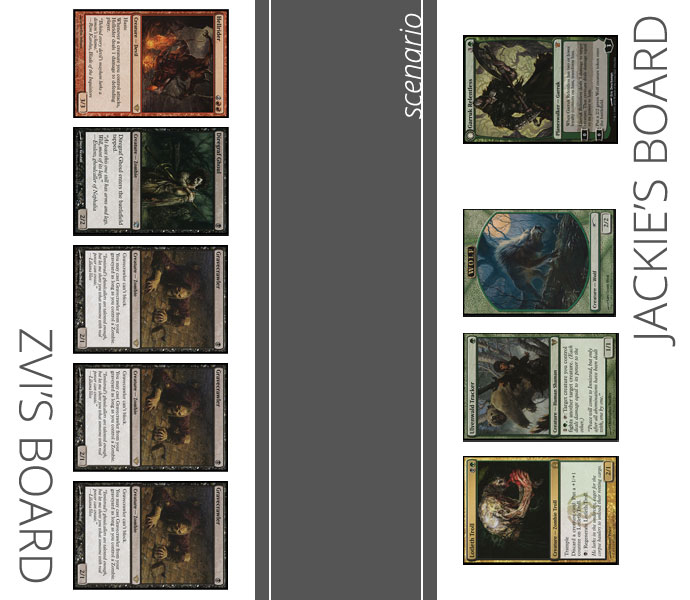
She needs to either block 1) Hellrider and Diregraf Ghoul; 2) Hellrider, Diregraf Ghoul, and Gravecrawler; or 3) Diregraf Ghoul and two Gravecrawlers. Option 1 puts her to three. She untaps and kills Hellrider, but then she can’t cast a substantial additional card, has used the Ultimate Price, is at one life, and can no longer start profitable fights with the Tracker. That seems awful.
Options 2 and 3 mean that the Wolf and the Tracker both die. These give her the choice to discard Dreg Mangler in order to trade the Troll with Hellrider. That way, Jackie can stay at three rather than two while preserving Ultimate Price for a potential future haste creature, which seems like the only move she can make, since going to two and not having the Ultimate Price gives me tons more outs and means that the vast majority of my deck likely kills her.
That leaves her with a hand of Increasing Savagery and Ultimate Price and a board of Garruk Relentless and lands facing down two Gravecrawlers. She untaps, draws, makes a new Wolf, and has Ultimate Price, but that won’t stabilize against the Gravecrawlers unless she uses Increasing Savagery or scavenges, both of which create all the same problems as the other lines.
This means that making the Wolf initially was a mistake.
Instead she must fight with Diregraf Ghoul, flipping Garruk Relentless to avoid a point of damage from Hellrider, which then gives me the option of killing Garruk at a reasonable price with a Hellrider activation. If I do that, I only have four attacks, and she’s only at nine, so she can reasonably get hit down to four and save one creature or trade off everyone and stay at six.
Meanwhile, if I don’t have the Hellrider, Garruk lives and has been established on the table (or Jackie keeps her life total at twelve), which means she’ll have a deathtouch Wolf to trade off with the Tracker and can safely trade off a bunch while staying at a manageable life total.
That last option appeals to me the most. Jackie’s most important job is to survive. With four powerful cards in her hand, her most important tasks are getting good use out of her mana and staying alive. Casting Increasing Savagery likely results in taking too much damage to survive, but hanging back on Ultimate Price makes the mana problem even worse. Casting Garruk Relentless and fighting a Diregraf Ghoul is an expensive stall for time, but it should still preserve a shot at winning the long game while not dying on the spot to the Hellrider that is likely waiting in my hand.
Jackie’s comment on this was the following:
I think that every play probably loses, too. Ultimately, I think the real problem was in my decision not to play Dreg Mangler on the previous turn when I blocked and regenerated my Troll instead. I was trying to avoid losing more if you had removal, but as we discussed, that entire line of logic is negated when I consider both that the removal would have just taken out my Tracker long ago or that it would have been used to burn me out after I’d gained board control.
To be honest, it might have been correct for me to trade the Tracker for tempo the first time you attacked with the Gravecrawler.
Of course, any of these short-term choices would have been worse if I’d drawn land in a timely manner. However, given what I drew, I think this would have given me the best chance of winning. I had multiple four-drops in my hand, so by the time I was able to cast them, I wouldn’t have also been able to activate the Tracker.
I considered playing Garruk and killing a creature, but I think that would have been a bad choice in the end because it would be so easy to kill him and still have me at a huge life advantage. If I were to play him, I think making a Wolf and having him at three would be the better choice, but even without another play, you could just attack with your Gravecrawlers alone to kill him or force me to lose my Troll. I don’t think I have any good options if you have Hellrider or removal, and it’s just a question of what is less bad.
The problem is that once you have a board of three Gravecrawlers, your board is superior without you casting any further spells. I can block/kill two per turn, allowing you to regrow after combat and still be breaking through with damage. Playing Garruk would increase the number of Gravecrawlers I can deal with to three, but only by tying up all of my resources every turn. Playing Dreg Mangler, allowing the Troll to trade with your Diregraf Ghoul, playing Garruk to make a Wolf, having you play nothing, then untapping to keep Ultimate Price up seems like the only way I could win, but it wouldn’t have been possible with me drawing the fourth land as late as I did.
Jackie’s insight is strong and on reflection clearly correct. She was afraid of removal, but logically I can’t have removal because I would have used it on turn 3, and we know what I’ve drawn since then. Casting Dreg Mangler earlier advances her board and puts her in a position to stabilize and get use out of the Tracker without black mana, leaving her the ability to do two things per turn as well as a good blocker. Always give yourself a way to win the game. There’s no point in guarding against them having certain cards if it means you lose the game no matter what they have!
Game 2 had three interesting turns for me, two of which I played incorrectly. Some would say "slightly incorrectly," but they would be wrong. As Jon Finkel says, there’s the right play, and then there’s the mistake.
On the fourth turn, I was holding Geralf’s Messenger, Pillar of Flame, and Searing Spear and had Geralf’s Messenger on the table facing down Vampire Nighthawk and Strangleroot Geist. The Pillar of Flame is destined for the Strangleroot Geist and the Searing Spear for the Vampire Nighthawk, but not attacking before casting Searing Spear was clearly a mistake for two reasons.
The first reason is that if Jackie wants to block, I prefer that to the alternative since I can respond to any trick with the Searing Spear and if there is no trick can cast the second Messenger and be in excellent shape. The second reason is what happened, which is that she had Ranger’s Guile and prevented me from attacking, which isn’t something that I considered at all.
I don’t think it was a mistake to not explicitly consider Ranger’s Guile, as one does not have infinite time, but the heuristic should always be to attack first if you’d be happy when they block. I broke that rule and was punished by missing three damage. A secondary question is whether I should cast Searing Spear on my turn or wait for Jackie’s turn because the most likely instant is Ranger’s Guile and I can force her to tap mana on her turn to protect the Vampire, but that means I take an extra damage and requires me to have a strong prior on any relevant spell being Ranger’s Guile; I don’t think I have that prior until she shows me the card.
The second decision, which I believe I made correctly, was whether to hold back Messenger to block a potential attacker. The commentators mention that I am potentially worried about Strangleroot Geist, which is true, and this is likely enough given how much harder it will become to lose the game once I hit once with her Increasingly Savage Vampire Nighthawk. That the extra damage is unlikely to buy her an additional turn, but it should be mentioned that Jackie’s deck also included Dreg Mangler. I had not seen one, but this was a very safe assumption.
The third decision came on Jackie’s final turn when I made a serious blunder by trying to kill her Lotleth Troll. On reflection, I have no idea why I did this, as taking a hit from the Troll was harmless at this point and I could cast Hellrider on my turn to kill Jackie through an untapped Troll before any creatures could die. By killing the Troll, I activate morbid, which allows Tragic Slip to kill Olivia and reclaim the Increasingly Savage Vampire Nighthawk. If she in fact has drawn Tragic Slip, there is a good chance I will now lose the game if she lets her Troll die, and I know she plays Tragic Slip.
There are other cards that kill Olivia that she could plausibly draw, the most likely being Sever the Bloodline. In theory, Murder is also possible. The price I pay in these cases would be to take a hit from the Troll since blocking would activate morbid, but having gained life off Nighthawk I can survive that hit. The two damage I save is far from nothing, but it’s far less likely to impact the game because it’s unlikely I can win from here against Sever the Bloodline. Luckily for me, Jackie chose to regenerate the Troll, which resulted in the play being good since it tapped down the Troll and her black mana at no cost to me, but it would have been fitting to punish me for my mistake and force a third game.
Sideboarding against Jackie required sorting through a lot of uncertainty about what was in her deck and which cards were important, as I’d never played a game against B/G until then. I knew I was facing aggressive creatures, including cards like Lotleth Troll and Predator Ooze that made it very difficult to fight on the ground and my removal questionable. Victim of Night was problematic since she had Zombies and potentially Vampires, and Ultimate Price may or may not have been effective against enough of her creatures to be good, so the only removal spells I knew I wanted were Tragic Slip and Pillar of Flame.
For the creature suite, I clearly wanted to put in Vampire Nighthawk and Olivia Voldaren and take to the air since her creatures were good at battling on the ground, but it was still largely a tempo battle so I didn’t want to fall behind either. Hellrider was an easy cut, in its usual role swapping out for Olivia, and the presence of Crimson Muckwader let me cut out Knight of Infamy without wrecking the curve.
The question was how many one-drops to keep in the deck since Vampire Nighthawk ate all the Knight of Infamy slots and we wanted to bring in removal. It’s defensible to take out Messengers for curve reasons, but doing that weakens Gravecrawler even more than cutting one-drops. What is right depends a lot on exact configurations, but it’s almost certainly right to have between four and six one-drops; dropping the full set would render the deck too slow.
Feature Match vs. Brian Kibler
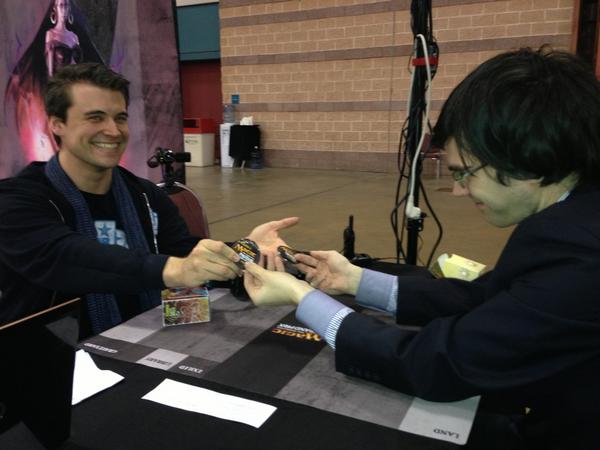
Initially, I assumed Kibler and Lee’s decks would be very close to each other, which turned out not to be the case. Kibler himself might have been increasingly savage, but his creatures were not. In addition, Kibler knew a lot more about what I was up to, bringing in Sever the Bloodline to deal with Olivia. The second game points to the advantages that my deck had against that, coming out fast with big threats that must be answered, while his deck had the advantage of having a number of interactions that let him take control over time, like flashing back Sever the Bloodline and using Ulvenwald Tracker with various good fighters.
Predator Ooze was certainly a big asset, especially since I only had one Tragic Slip in my 75 due to the danger of getting caught with two of them at the wrong time. Kibler later responded, "How rude!" when he saw my decklist and found out I had only one copy.
My games against Kibler were straightforward. The big decision in game 1 was whether to keep my hand despite not having a one- or two-drop in it. If I fail to draw one of my fifteen such creatures within two turns, especially if I also don’t draw a removal spell, I risk falling behind. That decision comes up a lot, and my feeling is that such hands in general must be kept if and only if they have a quality high-end plan. The first five lands are worth having, so it’s hard to throw a hand with four lands back in the hopes of doing better than that. I drew the Crimson Muckwader to keep pace, and when Kibler stumbled on mana, the game was over quickly.
The second game was also straightforward, as my ability to cast two removal spells on my second turn to follow up Gravecrawler allowed me to get ahead in the race. Sever the Bloodline is a good plan when the enemy is trying to block but won’t catch you back up once you’ve already fallen behind. There was also the curse of the card that’s too awesome to trade. I had a Gravecrawler hitting him for two while Deathrite Shaman hit me for one. Later on Deathrite Shaman will be a vastly superior creature, but because of that Kibler couldn’t trade to buy time even with a slow and controlling hand, which made the situation that much worse.
If I’d had to play game 3, the question would have been whether to stick with Olivia or to sideboard back into Hellrider since Kibler had Sever the Bloodline and I was now on the play. Should I make a play to blitz him out of the game with haste creatures? The issue is that it’s clear at this point that I want a bunch of removal in the deck, which makes it impossible to have enough creatures at all points in the curve at the same time; that’s why the maindeck doesn’t have a lot of removal.
It’s likely best to stick with Olivia because even having seen two Sever the Bloodline I don’t expect a full complement, and the card will likely be overloaded. Plus, I still have reason to think that my matchup is quite good. The better the matchup (against both deck and player, so this argument applies much less when up against Kibler), the more reluctant you should be to do something that risks leaving you pairing up badly without a lot of play.
As a side note, killing the Dragonmaster himself both games with a Dragon was pretty sweet.
Feature Match vs. Morgan Chang
Morgan Chang’s deck posed a much starker puzzle. Game 1 was a quick tempo victory, as his deck had no early drops and I had the Zealous Conscripts to knock him too low to recover, but then I was left with little information on what his bunch of cards was up to beyond knowing he was using Unburial Rites and had access to various trips to funky town in his 75.
After game 2, there was no question that he was playing with enough heavy duty tools that I couldn’t hope to steal games with Olivia Voldaren or by playing too many high impact men for him to handle. If I was to win the game, it would be on tempo. However, I didn’t know that at first.
Much of my early testing was with decks similar to Morgan’s. Morgan’s build had maindeck Centaur Healer, which made me think he was oriented lower or primarily a Junk-style deck splashing for Forbidden Alchemy. I’d tried the online Junk Reanimator decks out in testing and found them terrible; Alchemy was clearly worth splashing for.
When I’d played against Zombies, I’d found them going both over and under me depending on the draw, and I expected Morgan to lower his curve and bring in more cheap answers. So I thought there was a good chance I could go over him, while the fact that I was going second made it harder to go under him. If I was wrong, I knew I could send out the impression I was configured slow (since I was) and then play first in game 3 with a fast configuration.
That was what happened. In game 2, I came out with multiple Knights, which are great against Centaur Healer, but he had the Supreme Verdict and then had the Evil Twin with on the spot activation to effectively steal my Thundermaw Hellkite. This still put me on the verge of winning since I had Zealous Conscripts, but he was slightly too high for that. If I cast the Conscripts a turn earlier than I did, I could do the full eight damage, but it’s very unclear how I expect to finish the job if he leaves the Evil Twin Hellkite back to block. Instead, I cast Aristocrat to knock him into Zealous Conscripts range at five life. That couldn’t beat a Thragtusk without a little help if the Dragon held back because the attack in the air would only knock him down to one, but if the Dragon did attack I could steal Thragtusk.
If the Dragon held back, I could steal the Dragon, knock him down, and then sacrifice the Dragon, leaving him dead on board without more help. Instead, he cast Detention Sphere, which I was unaware of, and Centaur Healer to get himself both up to eight life and to have a blocker on the ground. The question now was how to give myself outs. I quickly dismissed holding the Zealous Conscripts since that would mana constrain me, so I had to go for one of two plays: I could steal Centaur Healer and attack him down to two or steal Thundermaw Hellkite and attack him down to three while trading off creatures on the ground. The trade seemed better given I didn’t have Hellrider in my deck but still left me with very little hope.
For game 3, I sideboarded into the full anti-control bum rush configuration, and Morgan’s draw was too slow to fight back. He’d sideboarded back out Golgari Charm, which left him extra vulnerable to this strategy.
Feature Match vs. Jonathan Sukenik
This was a win and in for Top 8. Unfortunately, my deck did not cooperate. In game 1, Jonathan drew four lands and three Hellriders, and I failed to find either a fourth land or enough cheap cards to compete with that, even though his draw was quite slow.
Game 2 was lost to the interaction of Thundermaw Hellkite and Falkenrath Aristocrat, which together with his other removal left Jonathan up a card and my board empty. The key decision point in that game was whether to cast Aristocrat and attack or spend the turn first casting multiple removal spells to wipe out his board. I figured I was ahead on life and was holding Zealous Conscripts, so I was better off keeping the pressure on. Instead, this led to his Hellkite coming down and taking out Aristocrat, but with two copies as my only creatures it would have been all but impossible to avoid this.
That raises the question, however, of whether they should have been my two creatures. I chose to keep all four copies of Aristocrat and instead take out Hellkites. Was that right? Ari Lax said outright that it was a huge mistake, as his deck "couldn’t beat a Hellkite" and certainly needs to either spend two removal spells or its own Hellkite. My thinking was that I was facing an opponent playing cards like Stromkirk Noble and Pyreheart Wolf; he’s trying to attack me and tempo me out, but his cards are worse.
He’s playing a faster version of my deck but with lower overall card quality, and I still have black removal for his Thundermaw Hellkites if it comes to that. My job is to survive and turn the tables, so I want to make my deck as fast as possible. Neither of us can block effectively, so speed kills. There’s also the fact that Falkenrath Aristocrat defends against Zealous Conscripts and other threaten effects, which he’s often going to have at least some copies of available.
I’m still not sure who is right. It is likely that the extreme vulnerability to Thundermaw Hellkite makes it right for me to have at least some copies, although definitely not the full four, and likely it gets played over Zealous Conscripts because keeping Falkenrath Aristocrat alive is harder than it looks. These decisions can be quite frustrating, as the cards you take out when you lower your curve are exactly the cards you want to have when you hit five mana, especially if you’re otherwise out of spells, but the games are lightning fast.
It’s no fun to play for Top 8 twice and lose, especially because the other win and in match was a lot less fun than my match against Sukenik. I was up against Esper and initially kept a hand on the draw consisting of four lands, two Geralf’s Messengers, and a Thundermaw Hellkite. That hand has its charms against Esper because they often rely on Supreme Verdict and the hand would nicely evade Lingering Souls, but it didn’t start playing spells until turn 3, so I needed to find something in the first two draws to tide me over, which happens about half the time. In this case no help came, and he slowly grinded me out of the game.
In the second game, I mulliganed a six-land hand into a five-land hand. I kept it and managed to get Olivia on the table, where she used my abundance of mana to feast on everything in sight, but he was ready with multiple copies of Terminus and eventually killed me with Lingering Souls and Sorin, Lord of Innistrad. Knowing you’re dead long before it happens but needing to play it out on the off chance you can scrape together the win is very little fun.
The rest of the tournament, however, was a lot of fun, and I’m very happy to have gotten back to attacking for two, or these days twelve. Team SCG Black will be testing right here in New York City this time around for Pro Tour Gatecrash, and I plan to be ready.

